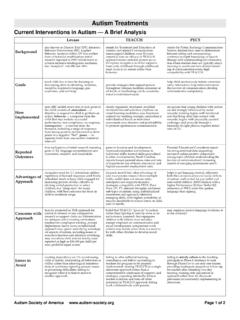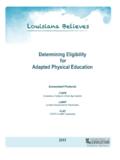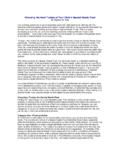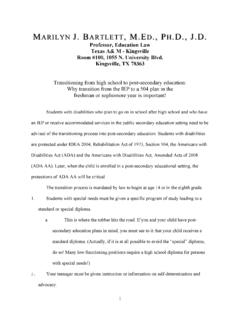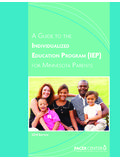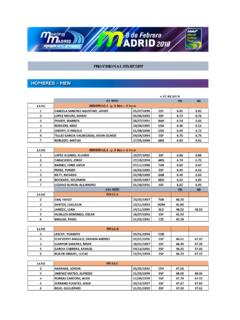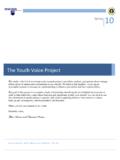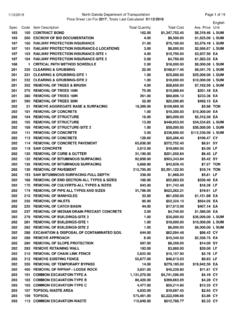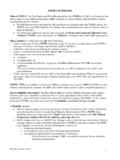Transcription of School Accommodations and Modifications - …
1 Families and Advocates Partnership for Education (FAPE)FAPE Coordinating Office: PACER Center, Inc. 8161 Normandale Blvd., Minneapolis, MN 55437952-838-9000 voice ~ 952-838-0190 TTY ~ 952-838-0199 fax ~ 1-888-248-0822 toll-freeWeb site: ~ E-mail: are encouraged to copy and share this information, but please credit PACER Accommodationsand ModificationsSome students with disabilities need accommodationsor Modifications to their educational program in orderto participate in the general curriculum and to be success-ful in School . While the Individuals with DisabilitiesEducation Act (IDEA) and its regulations do not defineaccommodations or Modifications , there is some agree-ment as to what they mean. An accommodation as used inthis document allows a student to complete the sameassignment or test as other students, but with a change inthe timing, formatting, setting, scheduling, response and/orpresentation. This accommodation does not alter in anysignificant way what the test or assignment of Accommodations include a student who isblind taking a Braille version of a test or a student taking atest alone in a quiet modification as used in this document is an adjust- ment to an assignment or a test that changes thestandard or what the test or assignment is supposed tomeasure.
2 Examples of possible Modifications include astudent completing work on part of a standard or astudent completing an alternate assignment that is moreeasily achievable than the standard Modifications and Accommodations should bewritten into a student s Individualized EducationProgram (IEP) or Section 504 Plan. These changesshould be chosen to fit the student s individual needs. It simportant to include the student, if appropriate, whendiscussing needed Accommodations and the student what would be helpful is a good are some ideas for changes in textbooks andcurriculum, the classroom environment, instructionand assignments, and possible behavior expectations thatmay be helpful when educating students with reviewing these ideas, keep in mind that anyaccommodations or Modifications an IEP team choosesmust be based on the individual needs of students, andthe changes must be provided if included in the child and CurriculumBooks Provide alternative books with similar concepts, but atan easier reading level.
3 Provide audiotapes of textbooks and have the studentfollow the text while listening. Provide summaries of chapters. Provide interesting reading material at or slightly abovethe student s comfortable reading level. Use peer readers. Use marker to highlight important textbook sections. Use word-for-word sentence fill-ins. Provide two sets of textbooks, one for home and onefor School . Use index cards to record major themes. Provide the student with a list of discussion questionsbefore reading the material. Give page numbers to help the student find answers. Provide books and other written materials in alternativeformats such as Braille or large Shorten assignments to focus on mastery of keyconcepts. Shorten spelling tests to focus on mastering the mostfunctional words. Substitute alternatives for written assignments (claymodels, posters, panoramas, collections, etc.).FAPE-27 Oct. 31, 2001 Families and Advocates Partnership for Education (FAPE) School Accommodations and Modifications - 2 Specify and list exactly what the student will need tolearn to pass.
4 Review this frequently. Modify expectations based on student needs ( , When you have read this chapter, you should beable to list three reasons for the Civil War. ). Give alternatives to long written reports ( , writeseveral short reports, preview new audiovisual materi-als and write a short review, give an oral report on anassigned topic).Classroom Environment Develop individualized rules for the student. Evaluate the classroom structure against the student sneeds (flexible structure, firm limits, etc.). Keep workspaces clear of unrelated materials. Keep the classroom quiet during intense learning times. Reduce visual distractions in the classroom (mobiles,etc.). Provide a computer for written work. Seat the student close to the teacher or a positive rolemodel. Use a study carrel. (Provide extras so that the studentis not singled out.) Seat the student away from windows or doorways. Provide an unobstructed view of the chalkboard,teacher, movie screen, etc.
5 Keep extra supplies of classroom materials (pencils,books) on hand. Use alternatives to crossword puzzles or word finds. Maintain adequate space between and AssignmentsDirections Use both oral and printed directions. Give directions in small steps and in as few words aspossible. Number and sequence the steps in a task. Have student repeat the directions for a task. Provide visual aids. Show a model of the end product of directions ( , acompleted math problem or finished quiz). Stand near the student when giving directions orpresenting a Alert student several minutes before a transition fromone activity to another is planned; give severalreminders. Provide additional time to complete a task. Allow extra time to turn in homework without penalty. Provide assistance when moving about the Use worksheets that require minimal writing. Use fill-in questions with space for a brief responserather than a short essay. Provide a designated notetaker or photocopy ofother student or teacher notes.
6 (Do not require a poornotetaker or a student with no friends to arrange withanother student for notes.) Provide a print outline with videotapes and filmstrips. Provide a print copy of any assignments or directionswritten on the blackboard. Omit assignments that require copying, or let thestudent use a tape recorder to dictate Provide a partial grade based on individual progress oreffort. Use daily or frequent grading averaged into a grade forthe quarter. Weight daily work higher than tests for a student whoperforms poorly on tests. Mark the correct answers rather than the incorrectones. Permit a student to rework missed problems for abetter grade. Average grades out when assignments are reworked,or grade on corrected work. Use a pass-fail or an alternative grading system whenthe student is assessed on his or her own Go over directions orally. Teach the student how to take tests ( , how toreview, to plan time for each section).
7 Provide a vocabulary list with definitions. Permit as much time as needed to finish tests. Allow tests to be taken in a room with few distractions( , the library). Have test materials read to the student, and allow oralresponses. Divide tests into small sections of similar questions orproblems. Use recognition tests (true-false, multiple choice, ormatching) instead of essays. Allow the student to complete an independent projectas an alternative test. Give progress reports instead of grades. Grade spelling separately from content. Provide typed test materials, not tests written incursive. Allow take-home or open-book tests. Provide possible answers for fill-in-the blank sections. Provide the first letter of the missing Allow the student to use a calculator without penalty. Group similar problems together ( , all addition inone section). Provide fewer problems on a worksheet ( , 4 to 6problems on a page, rather than 20 or 30).
8 Require fewer problems to attain passing grades. Use enlarged graph paper to write problems to helpthe student keep numbers in columns. Provide a table of math facts for reference. Tape a number line to the student s desk. Read and explain story problems, or break problemsinto smaller steps. Use pictures or Use Post-it notes to mark assignments in textbooks. Check progress and provide feedback often in the firstfew minutes of each assignment. Place a ruler under sentences being read for bettertracking. Introduce an overview of long-term assignments so thestudent knows what is expected and when it is due. Break long-term assignments into small, sequentialsteps, with daily monitoring and frequent grading. Have the student practice presenting in a small groupbefore presenting to the class. Hand out worksheets one at a time. Sequence work, with the easiest part first. Use blackline copies, not dittos. Provide study guides and study questions that directlyrelate to tests.
9 Reinforce student for recording assignments and duedates in a notebook. Draw arrows on worksheets, chalkboard, oroverheads to show how ideas are related, or use othergraphic organizers such as flow Arrange a check-in time to organize the day. Pair the student with a student who is a good behaviormodel for class projects. Modify School rules that may discriminate against thestudent. Use nonverbal cues to remind the student of ruleviolations. Amend consequences for rule violations ( , reward aforgetful student for remembering to bring pencils toclass, rather than punishing the failure to remember). Minimize the use of punishment; provide positive aswell as negative consequences. Develop an individualized behavior intervention planthat is positive and consistent with the student s abilityand skills. Increase the frequency and immediacy of and Advocates Partnership for Education (FAPE) School Accommodations and Modifications - 3 Families and Advocates Partnership for Education (FAPE) School Accommodations and Modifications - 4 Arrange for the student to leave the classroom volun-tarily and go to a designated safe place when underhigh stress.
10 Develop a system or a code word to let the studentknow when behavior is not appropriate. Ignore behaviors that are not seriously for the FAPE Project comes from the Department of Education, Office of Special Education Programs (Coopera-tive Agreement No. H326A980004). This document was reviewed by the U. S. Office of Special Education Programs (OSEP),the OSEP Project Office, and the FAPE Project Director for consistency with the Individuals with Disabilities Education ActAmendments of 1997. The contents of this document do not necessarily reflect the views or policies of the Departmentof Education, nor does mention of other organizations imply endorsement by those organizations or the Government. Develop interventions for behaviors that are annoyingbut not deliberate ( , provide a small piece of foamrubber for the desk of a student who continually taps apencil on the desktop). Be aware of behavior changes that relate to medicationor the length of the School day; modify expectations ifappropriate.
